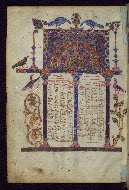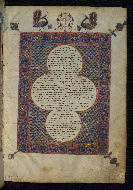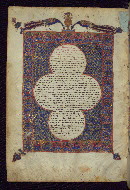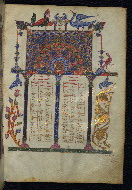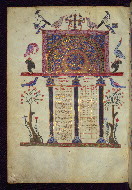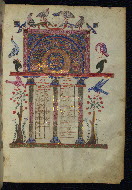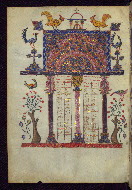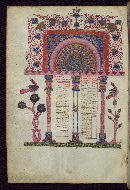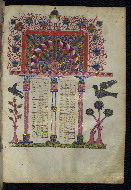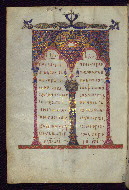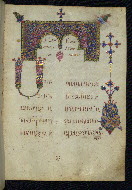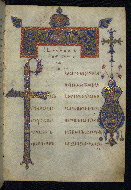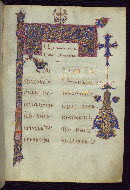Home > Digitized Walters Manuscripts
This document is a tranformation of a TEI P5 XML manuscript description incorporating images. If you have trouble reading special or non-Latin characters on this page, please make sure you have appropriate Unicode fonts installed and an up-to-date web browser.
Walters Ms. W.538, Gospels
Browse images (Browse images in a new window) | TEI in XML format
W.538
Gospels
Vernacular: Աւետարան
This Gospel Book was produced at the end of the katholicate of Grigor IV (Tłay) at the monastery of Pawłoskan in Cilicia. The principal colophon on fols. 311r-313v dates the manuscript to 1193 CE (642 AE), and the patron, Bishop Karapet, a resident at the court of Grigor at Hromkla, is recorded in the dedication on fol. 12v. The colophon also records the siege of Jerusalem by Saladin in 1187, the Third Crusade (1189-1192) and Frederick Barbarossa's attempt to reclaim Palestine, and Barbarossa's death in 1190. The canon tables and the Eusebian letter within quatrefoil frames are decorated with architectural elements, geometric designs, floral motifs, and birds. The codex is further illuminated with historiated and inhabited initials forming the incipits of the Gospels and marginal decoration.
1193 CE
Hromkla, Armenia
Book
Scriptural
The primary language in this manuscript is Armenian.
- In vernacular: Fol. 311r in erkat‘agir Փառք ամենասուրբ երրորդութեանն հաւր և որդւոյ և հոգւոյն սրբոյ յաւիտեանս յաւիտենից, ամէն: Fol. 311v in erkat‘agir Յամի Ո արիրերորդի քառասներորդի երկրորդի հայկազնեան տոմարիս [= 1193] : Ւ հայրապետութեանն տեառն Գրիգորի կաթողիկոսի Հայոց: Եւ յիշխանութեան բարեպաշտ իշխանին Լևոնի, իսկ ի բռնակալութեան Հաքարացւոց ումեմն Սալահըտտին կոչեցեալ ըստ իւրեանց առասպելաբանութեանն: Որ և տիրեաց Եգիպտացւոց և մինչև ի կողմանս արևելից, և զբազումս յազգայնաց իւրոց արկեալ ընդ իշխանութեամբ իւրով: Եւ զաւրացեալ այսու, սկսաւ պատերազմել ընդ սուրբ քաղաքն Երուսաղէմ, և ընդ զաւրս նորա: Զորս թուլագոյնս գտանէր ի հաւատս, զնոսա կարասեաւ և խոստմամբ պարտէր: Եւ որ քաջ սպառազէնքն էին, բանիւք ողոքանաւք հաւանեցուցանէր, և զայլս ի մեծամեծացն (Fol. 312) երդմունս հաստատէր, նոցա ունել զտերութիւն աշխարհացն, և այսպիսի խորամանկութեամբ քակեաց զամենեսեան ի միմեանց և արար ի միում տան խռովութիւն: Եւ զայս արարեալ ի բազում ամս, ոչ կարաց յաղթել նոցա, և ապա աւրինաւք խնդրէր պատերազմել ընդ նոսա, զի գիտէր զթուլութիւն և զերկպառակութիւն զաւրացն, և զյետս կացելոցն ի սուրբ ուխտէն: Եւ պատերազմեալ ընդ նոսա յաղթեաց, զի զաւրքն ընդ չորս մասունս բաժանեալ էին, և ձերբակալ արարեալ զթագաւորն և զարս պատերազմողս որ կոչին Փրերք, և զայլ զաւրսն կոտորեաց, և բռնացեալ առ զսուրբ քաղաքն Երուսաղէմ և զԱսկողովն և զամենայն սահմանս աշխարհին, և գա ի սահմանս Անտիոքու և քակեալ աւերեաց զաշխարհն և զամուրս նորա: (Fol. 312v) Եւ անարին այն որ (բր)ինձ կոչեցեալ ոչ կարաց ելանել ընդդէմ նորա, իսկ նորա կատարեալ զկամս իւրոյ չարութեանն, կամեցաւ մտանել յաշխարհն Կիւլիկեցւոց, նոյնպես կարծելով զնոսա անարիս գոլ, քամզի գայր իբրև զառե ւծ զաւրաւոր, և դառնայր իբրև զաղուես տկար: Քանզի յառաջ ասացեալ հայրապետն սուրբ Գրիգորիոս, որ ունէր զաթոռ հայրապետական սրբոյն Գրիգորի, որ և շառաւ եղ գոլով նորին Լուսաւորչին Հայոց, պահպանեալ ընդ ամրածածուկ աջովն Աստուծոյ յամուր դղեկին կոչեցեալ Ռոմելիոսի Կլայ: Որ և սա բազում նեղութիւնս կրեալ ի շրջաբնակ այլազանիցն, ընդդեմ կացեալ աղաւթիւք և զաւրութեամբն Աստուծոյ: Եւ ըստ տուեցելոյ նմա յԱստուծոյ ամենաշնորհ իմաստութեանն, խրատէր և զաւրացուցանէր զթագաւորն և զաւրսն Կիւղիկեցւոց (Fol. 313r) ընդդեմ կալ նորա չարութեանն, որ և ոչ ևս կարաց ձեռն արկանել ի նոսա: Այլ քանզի հայրապետն սուրբ տեսանելով զայսպիսի նեղութիւն տարակուսանաց, զառումն սրբոյ քաղաքին, և զաւերումն սրբոց տաճարացն և զգերութիւն ժողովրդեանն Աստուծոյ և զայլանդակ գործ պղծութեան նոցա, զորս ոչ է պարտ արկանել ընդ գրով: Զայսոսոիկ տեսեալ սրբոյ հայրապետին, վշտացեալ ի հոգի իւր, միշտ աղաւտից և արտասուաց պարապեալ, խնդրէր զփրկութիւն սրբոյ քաղաքին եւ ժողովրդեանն Աստուծոյ: Գրէր և ցուցանէր զամենայն թագաւորացն Յունաց և Հռովմայեցւոց, զի թե իցեն ինչ ձեռնհաս, եկեսցեն յաւգնութիւն քրիստոնէից, և ինքն աղաւթից և սրբութիւն պարապեալ: Եւ ահա շարժեալ մի ոմն ի թագաւորաց Հռովմայեցւոց, Ալաման կոչեցեալ, գա մինչև ի սահմա (Fol. 313v) նաւ Կիւղիկեցւոց և ոչինչ աիրութիւն ցուցեալ, կատարի մահուամբ գետասոյզ եղեալ, և զաւրքն ցրուեալ բաժանեցան, և մինչև ցայս վայր ինքն բռնացեալ ունի զքաղաքն սուրբ յառաջասացեալ գազանն հաքարացի: Եւ արդ յաւուրս յորս ասացաւ, ստացաւղ եղեալ սրբոյ տառիս սրբազան եպիսկոպոսն տէր Կարապետն, քուերորդի գոլով սրբոյ վարդապետին Պաւղոսի, բնակելով առ սուրբ հայրապետին, տեառն Գրիգորի, որ և արժանաւորեալ աշտիճանի եպիսկոպոսութեան, որպէս և վայել է Աստուծոյ տնտեսի: Եւ արդ սիրող գոլով պատուիրանաց տեառն, մանաւանդ աւետարանական քարոզութեան նորին: Եւ արդ ստացաւ զսա ի յիշատակ հոգւոյ իւրոյ և ի պարծանս եկեղեցւոյ: Եւ գրեցաւ սա յանապատիս որ կոչի Պաւղոսկան, մերձ առ ամուր դղեկիս Կատինոյ, առ ... Fol. 314r. In large bolorgir. Յիշատակ է աւետարանս Խաւճայ Յովանիսին, եղբաւրն Յուղուրլուին, հաւրն Ինապին, մաւրն Զատային, ի դուռն սուրբ Թումայ առաքալին վանքն, յիշաւղն ողորմի ասացէք: ամէն: Fol. 314v. In large bolorgir. Յանուն հաւր և որդւոյ և հոգւոյն սրբոյ: Ես Սմբատ մեղապարտ ծառա Աստուծոյ, Որ խնդրեցի զսուրբ աւետարանս ի հաւղաւրբաւրէն (հաւրեղբաւրէն) իմմէ, և ի հոգևոր տեառնէն, տէր Ոհաննիսի Հայւոց կաթողիկոսէ: Եւ նմա շնորհեալ զսա ինձ ի վայելումն կենաց իմոց, և ի յիշատակ հոգւոյ իմոյ, և ծնողաց և եղբաւր: Արդ որ կարդայք զսուրբ աւետարանս կամ աւրինակէք, զմեղապարտ ծառայս Աստուծոյ զՍմբատ, և զծնողս իմ և զեղբայրն յաղաւթս ձեր անմոռաց յիշեսջիք, և Աստուած ձեզ և մեզ ողորմեսցի յիւրում գալստեանն, ամէն, ամէն: ՈՀ (=1221).
- Translation: Fol. 311r Glory to the most holy Trinity, the Father and the Son and the Holy Spirit in all eternity, amen. Fol. 311v In the year 642 [= 1193] of the Armenian calendar. During the Patriarchate of Lord Grigor (Tghay) Katholikos of the Armenians. And in the reign of the pious Prince Lewon, but under the tyranny of a certain Saladin of the Hagarites as he is called according to their idle talk. Who also reigns over the Egyptians and up to the eastern regions, and who has subjected many of their nation under his rule. And having grown stronger thereby, he began to wage war with the Holy City of Jerusalem and with its forces. Whom he found to be most weak in faith, he subdued them with riches and with promises. And those who were well-armed he persuaded with words of adulation, and the others from among the grandees (Fol. 312) he guaranteed with oaths, that they would hold dominion over the lands, and through such cunning he separated every one from each other and created sedition in a unified house. And having done this for many years, he could (nevertheless) not overcome them, and then he sought pretexts to wage war with them, because he knew about the weakness and the discord of the army, and those who had desisted from the holy covenant. And having waged war with them he was victorious, because the armies were divided into four parts, and having captured the king and the warring men called Frères, he also slaughtered the other armies, and having invaded (it) he took the holy city of Jerusalem and Askalon and all areas of the land, and he came to the region of Antioch and having demolished (it) he ruined the land and its strongholds. (Fol. 312v) And the cowardly one called Prince could not go out against him, and he, having executed the desires of his wickedness, wished to enter into the land of the Cilicians, being of the opinion that they were likewise cowardly, because he came like a powerful lion and returned like a weak fox. Because the aforementioned Patriarch the holy Grigorios [Grigor IV Tłay Pahlawuni], who held the patriarchal see of Saint Grigor [Saint Gregory the Illuminator], who was himself a scion of the same Illuminator of the Armenians, (was) preserved under the protecting right hand of God in the strong fortress called Romelios Klay [Hŕomkla]. He had also suffered much hardship at the hand of the surrounding Muslims, withstanding (them) through prayer and the power of God. And in accordance with the most gracious wisdom bestowed upon him by God, he admonished and emboldened the king and the army of the Cilicians (Fol. 313) to oppose his wickedness, so that he would no longer be able to lay hands on them. But (this was) because the holy Patriarch saw such affliction of tribulation, the capture of the Holy City, and the ruination of the holy temples and the captivity of the people of God and their [that is, the enemy’s] monstrous deed(s) of profanation, which it is not necessary to put in writing. Having seen these things, the holy Patriarch, afflicted in his soul, always devoted himself to tearful prayer [lit.: prayer and tears], asked for the delivery of the Holy City and of the people of God. He wrote and showed all the kings of the Greeks and of the Romans [that is, the European Catholic monarchs], that if they had any means at all, they might come to the aid of the Christians, and he devoted himself to prayer and holiness. And behold, one of the kings of the Romans, called Alaman, having been roused, came to the border of the Cilicians and not having showed any valor, died by drowning in the river, and his army, scattered, divided itself, and until this time the aforementioned brute (of a) Hagarite, tyrannizing (it), holds the Holy City. And now, in the days in which it was said [that is, above], the sacred Bishop Lord Karapet, having become the receiver of this holy Scriptures, being the son of the sister of the holy vardapet [doctor of theology] Pawłos, resides with the holy Patriarch, Lord Grigor, who had deigned him worthy of the rank of Bishop, as it is pleasing to the steward of God. And he is a lover of the commandments of the Lord, in particular of his evangelical preachings. And he received this in memory of his soul and for the splendor of the Church. And this was written in this monastery which is called Pawłoskan, near the strong fortress of Katin, at …
Parchment
Medium-weight parchment, well finished; minor staining in the last quire margins
Foliation: i+317
Modern pencil foliation upper right corner (used here); on fols. 310v-314v another modern ink set of numbers (296-297, and 1-7), upper right corners, rectos and versos
Formula: 1(4), 2-5(8), 6(7), 7-11(8), 12(10), 13(2), 14-31(8), 32(6), 33-41(8)
Signatures: The quires are indicated by the successive letters of the Armenian alphabet written on the first page of each quire, beginning again after the last letter k'
Comments: The order of the first folios was changed when the manuscript was rebound; the proper order is fols. 4, 3, and 2
18.5 cm wide by 26.4 cm high
11.8 cm wide by 18.0 cm high
- Columns: 2
- Ruled lines: 19-21
- Hard-point ruling; layout does not apply to the canon tables on fols. 2v-11r, or the dedicatory inscription on fol. 12v
- Title: Gospel Book
- Decoration note: Illuminated headpieces introduce the Gospels; the Eusebius letter, the eight canon tables, and the dedicatory inscription are elaborately framed; marginal ornaments including crosses, palmettes and floral motifs throughout the manuscript (6 to 10 lines); illuminated initials for the Gospels and the lessons; opening page of Gospel text written in red/gold; text in black ink
- Title: Canon tables
- Contents: Fol. 2v: Canon 1; fols. 5r-11r: Canons 2-10; the letter of Eusebius has been rebound between the first canon and the following, on fols. 3r-4v, and has been given its own part
- Decoration note: Architectural frames, birds, and floral design, fols. 2v, 5r, 6v, 7r, 8v, 9r, 10v, 11r
- Title: Letter of Eusebius to Carpianus
- Decoration note: Full-page ornamental frame around quatrefoil- shaped text, fols. 3r and 4v
- Title: Dedication
- Contents: Vernacular transcription: in erkat‘agir Աստուածապատիւ տեառն Կարապետին է ստացեալ յիշատակ իւր և ի վայելումն անձին իւրոյ: Որք ընթեռնոյք յիշեսջիք ի Քրիստոս Յիսուս: Եւ զսուրբ վարդապետ նորին զՊաւղոս փոխեալ յաշխարհէ և զամենայն ազգատոհմ իւր աղաւթիւք յիշեսջիք ի Քրիստոս Յիսուս:
- Decoration note: Architectural frame
- Title: Gospels
- Contents: Complete except for Mark 16:9-20 and John 7:53-8:11. Fols. 13r-94v: Gospel of Matthew; fols. 96r-153v: Gospel of Mark; fols. 154r-242v: Gospel of Luke; fols. 244r-311r: Gospel of John; sentences from the Gospels written at a later date, fol. 316v
- Decoration note: Illuminated headpieces introduce the Gospels fols. 13r, 96r, 154r, 244r; marginal ornaments throughout; illuminated initials for the Gospels and the lessons
fol. 2v:
fol. 3r:
fol. 4v:
fol. 5r:
fol. 6v:
fol. 7r:
fol. 8v:
fol. 9r:
fol. 10v:
fol. 11r:
fol. 12v:
fol. 13r:
fol. 96r:
fol. 154r:
fol. 244r:
The binding is not original.
Leather over wooden boards, blind-tooled with linear designs. Triangular metal plaques, incised with floral motifs, are nailed at the corners of the upper cover. Four quaterfoil plaques have been nailed in a random arrangement on this cover, one being of unornamented silver. Two, of a base metal, each display a small relief of the crucified Christ. One is incised with an inscription in Armenian: "The cross is a memorial of Nazlu Kha[t'un] and her son Gevork', and she gave this healing holy Gospels for the enjoyment of Ter Hohannes, in the year 1770."
Made at the Monastery of Pawłoskan for Bishop Karapet in 1193 (see dedicatory inscription, fol. 12v and colophon)
Katholikos Ōhannēs (Yovhannēs VI) presented it to his nephew Smbat, in 1221, at the patriarchal see of Hromkla (see colophon, fol. 314v)
In the possession of Gēvork', son of Nazluxan, in 1770 (see inscription on upper board), who gave it to the priest Yōhannēs
Undated inscription on fol. 314r states that the manuscript was given to the Monastery of T'umay Aṙak'eal (Apostle Thomas) in memory of Xawčay Yovanēs, his brother Yułut'lu, father Inap, and mother Zatay
On the evidence of catalogues from 1889 (Zarbhanalian) and 1903 (Shahaziz), the manuscript was at New Nakhijevan during this period
Henry Walters, Baltimore, acquired between 1903 and 1931
Walters Art Museum, 1931, by Henry Walters' bequest
Thanks are expressed to Professor Bernard Coulie (Université catholique de Louvain, Louvain-la-Neuve) for kindly making available his bibliography on the Armenian manuscripts kept in the Walters Art Museum.
Alishan, Léonce M. Sissouan ou l'Arméno-Cilicie: Description géographique et historique. Trans. Édouard Sirounian and Jacques Issaverdentz. Venice: S. Lazare, 1899; p. 156. Armenian edition, Venice: S. Lazaro, 1885, pp. 147, 445.
Zarbhanalian, G. Catalogue des anciennes traductions arméniennes: Siècles IV-XIII [in Armenian with French title]. Venice, 1889, p. 160.
Alishan, Léonce M. Hayapatum [in Armenian]. Venice, 1901, pp. 409-410.
Shahaziz, Z. Historical Pictures [in Armenian]. Tiflis, 1903, p. 130.
De Ricci, Seymour, and W. J. Wilson. A Census of Medieval and Renaissance Manuscripts in the United States and Canada. Vol. 1. New York: H. W. Wilson Co., 1935, p. 761, cat. no. 25.
Der Nersessian, Sirarpie. Armenia and the Byzantine Empire: A Study of Armenian Art and Civilization. Cambridge: Harvard University Press, 1947, p. 122, plate XXIV.2.
Downey, Glanville. "The Art of New Rome at Baltimore." Archaeology 1 (March 1948): pp. 21-29, p. 24.
Hovsep'ian, G. Colophons of Manuscripts [in Armenian]. Antilias: 1951, cols. 565-570, 817-818.
Hoffman, Konrad. The Year 1200: A Centennial Exhibition at the Metropolitan Museum of Art. New York, 1970, pp. 295, cat. no. 288 (mislabeled Ms. 528).
Der Nersessian, Sirarpie. Armenian Manuscripts in the Walters Art Gallery. Baltimore: Trustees of the Walters Art Gallery, 1973, pp. 6-9, 85-86, plates 12-29.
Sanjian, Avedis K. A Catalogue of Medieval Armenian Manuscripts in the United States. Berkeley and Los Angeles: University of California Press, 1976, pp. 267-273.
Evans, Helen. "Manuscript Illumination at the Armenian Patriarchate in Hromkla and the West." Ph. D. diss. New York University, 1990, pp. 156-157
Mathews, Thomas F., and Roger Wieck, eds. Treasures of Heaven: Armenian Illuminated Manuscripts. New York and Princeton: The Pierpont Morgan Library and Princeton University Press, 1994, pp. 40, fig. 18 (fol. 246), 70, 71, 149, cat. no. 7 (Helen Evans)
Principal catalogers: Der Nersessian, Sirarpie; Landau, Amy; van Lint, Theo M
Catalogers: Dennis, Nathan S; Valle, Chiara
Editor: Herbert, Lynley
Copy editor: Dibble, Charles
Conservators: Owen, Linda; Quandt, Abigail
Contributors: Bockrath, Diane; Emery, Doug; Noel, William; Tabritha, Ariel; Toth, Michael B.
The Walters Art Museum
Licensed for use under Creative Commons Attribution-NonCommercial-ShareAlike 3.0 Unported Access Rights, http://creativecommons.org/licenses/by-nc-sa/3.0/legalcode. It is requested that copies of any published articles based on the information in this data set be sent to the curator of manuscripts, The Walters Art Museum, 600 North Charles Street, Baltimore MD 21201.
